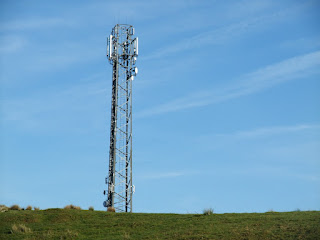Comprehensive article on the impact of wireless on the environment: climate, people, animals, birds, insects... by Annelie Fitzgerald PhD, member of Wiser Wireless Wales.
by Annelie Fitzgerald, medium.com, 20 Dec. 2021
A call for UK environmentalists to wake up to wireless pollution
 |
| Mobile telecommunications mast. Photo: Annelie Fitzgerald |
But it’s not just data capacity that consumes electricity; wireless infrastructure and gadgets do too. Generating a wireless signal requires energy, and many wireless devices emit signals fairly continuously, whether they are in use or not.
Although its focus was people’s connectivity during recent lockdowns rather than reducing carbon emissions, the UK communications regulator Ofcom has recommended using landlines to ensure more reliable phone connections. It has also advised the public to “try wired rather than wireless” and, for “the best broadband speeds”, to connect computers to routers using Ethernet cables rather than Wi-Fi.
Landlines and wired internet connections also happen to be the most energy-efficient means of communication. Internet access through Wi-Fi already increases energy use, but this soars by 15 times if access is through 3G, and can be 23 times greater through 4G. In a report titled Reinventing Wires commissioned by the US National Institute for Science, Law and Public Policy, communications technology expert Timothy Schoechle concluded that wired infrastructure is “inherently more future-proof, more reliable, more sustainable, more energy efficient” than wireless networks. This ‘inconvenient’ truth should give all environmentalists pause for thought.
Wireless is pollution
Switching to wired connectivity has the added benefit of reducing personal exposure to the radiofrequency radiation (RFR) produced by wireless devices, along with the overall man-made RFR burden within the environment. Yet, with wireless tech growing in prevalence (e.g. cordless phones, smartphones, tablets and chargers, plus wearables, smart meters, smart speakers and baby monitors), RF pollution is escalating.
Levels of anthropogenic RFR are now billions of times greater than natural background levels. In her fascinating book The Spark of Life. Electricity in the Human Body (2013), Oxford physiology professor Frances Ashcroft reminds us that living beings rely on “an unimaginably complex and continuously changing pattern of electrical and chemical signals.” Is it therefore reasonable to expect man-made RFR to have no impacts on the exquisitely small natural electromagnetic fields upon which all life depends? The authors of a paper, “Planetary electromagnetic pollution: it is time to assess its impact”, published in The Lancet Planetary Health in 2018, think not. They report that 68% of 2,246 recently evaluated studies demonstrated “significant biological effects”.
Continue reading:
No comments:
Post a Comment
Note: Only a member of this blog may post a comment.